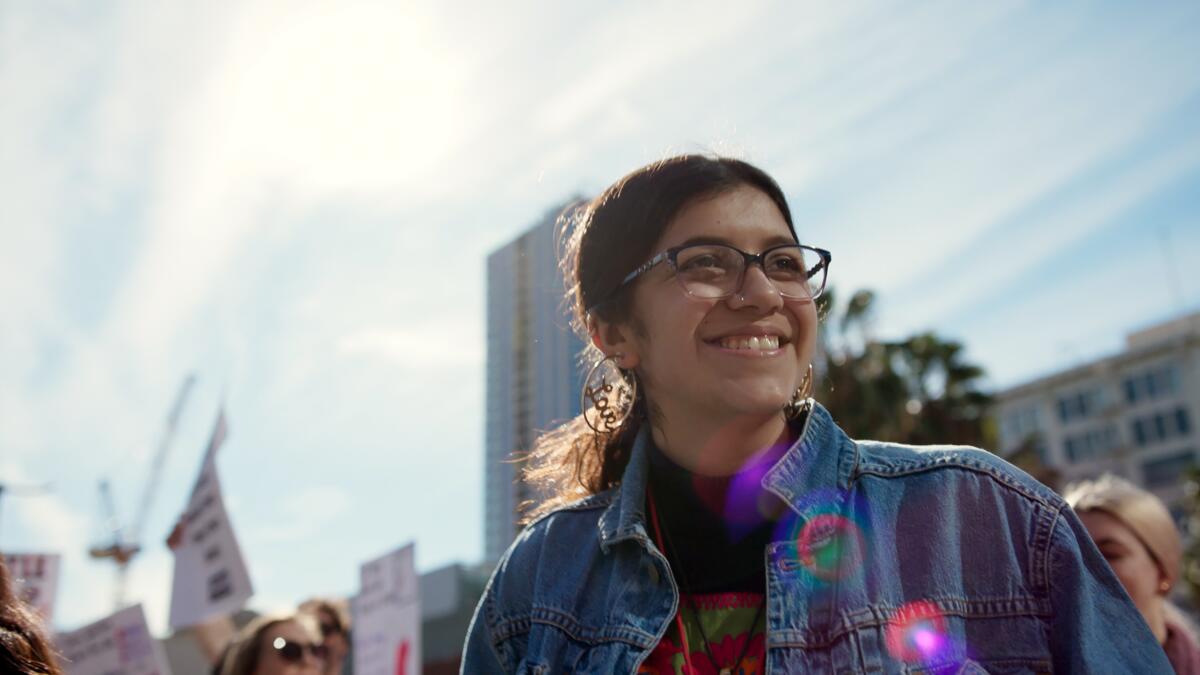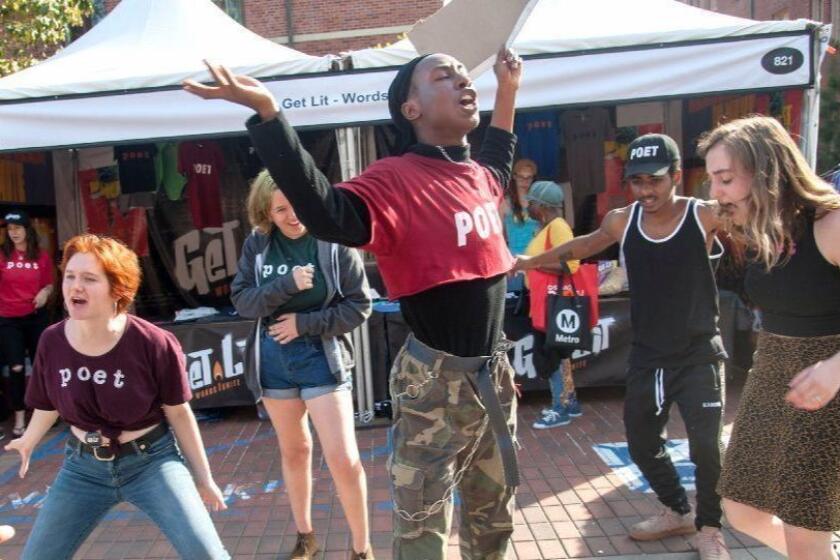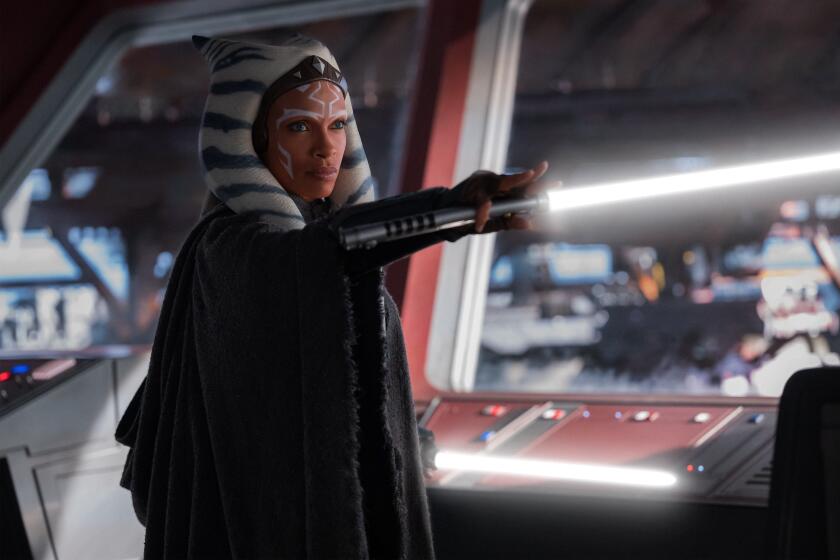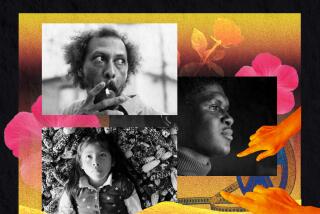‘Our Words Collide’ documents 5 L.A. teen poets testifying to spoken word’s transformative power

The front rows of L.A.’s historic Wilshire Ebell Theatre were occupied Saturday by more than 20 high school students, clutching each other’s hands and reciting verses under their breath as they prepared to compete in the championship round of the world’s largest classic poetry slam.
The Classic Slam, hosted and produced by L.A.-based education nonprofit Get Lit — Words Ignite, is a three-day capstone event for the 50,000-plus students who complete Get Lit’s UC-approved poetry curriculum annually — culminating in Saturday’s Grand Slam Finals.
Nia Lewis hated dodging strangers making leering comments on the street.
Following Get Lit’s trademark call-and-response model, wherein students “claim” classic poems from the Get Lit poetry anthology and write original responses to them, Saturday’s competitors recited both original compositions and classics from Ross Gay’s “Throwing Children” to Kendrick Lamar’s “How Much a Dollar Cost.” Throughout the night, the crowd was brought to tears, applause and howling laughter.
It was while attending the same event six years ago that filmmaking duo Jordan W. Barrow and Matt Edwards were struck with the idea for their feature-length documentary “Our Words Collide,” which will be released Tuesday by Freestyle Digital Media, and will be available to rent or buy from most streaming platforms, including Apple TV, Prime Video and YouTube. The film premiered in 2022 at the Santa Barbara International Film Festival, where it won the Anti-Defamation League Stand Up Award.
Executive produced by “Ahsoka” star Rosario Dawson and Get Lit Founder Diane Luby Lane, among others, “Our Words Collide” follows five Get Lit poets through their senior year of high school. The film blends footage self-shot by the teenage poets, dramatized poetry performances and animation, bringing their stories to life.
The latest ‘Star Wars’ spinoff reunites Ahsoka Tano, Sabine Wren and Hera Syndulla, and it showcases a broader view of what heroes look like in a galaxy far, far away.
Barrow and Edwards pitched the project in 2018 to Lane, who was immediately on board. She introduced the duo to the Get Lit Players, the organization’s award-winning performance troupe of youth poets. The filmmakers settled on five students to feature in the film: Jason Alvarez, Cassady Lopez, Amari Turner, Virginia Villalta and Tyris Winter.
“It was a really organic process,” Barrow said. “These five poets just really felt like they would be perfect for this kind of project.”
They also had diverse performing and writing styles, which Barrow and Edwards thought important to showcase. Whereas a poet like Alvarez is playful, Winter is fierce; Villalta is commanding, while Lopez is wistful. Turner leans the most confessional of them all.
“They all had such unique points of view, both in their personal lives but also in their poetry,” Barrow said. “We just felt like they really inspired us, and if we felt inspired and transformed by seeing their work, seeing their stories unfold, it felt like maybe audiences would have that same feeling.”
Filming began in September 2019 and lasted through 2020. For the first few months, Barrow and Edwards focused mainly on building rapport with the poets. Some days, they didn’t film at all. They said they didn’t want to rush things, and because both were balancing other jobs, they couldn’t have anyway, leading them to ask the young poets to film themselves.
“By the time you’ve spent the weekend with one of the poets, you’re like, ‘Wow, it’s going to take five weeks before we see Jason again,’” Edwards said. “That sparked the idea of, like, ‘Why don’t we give them all cameras?’”
They told the poets to film themselves when they felt inspired, when they were writing or just whenever they felt like it. When a poet filled a memory card, either Barrow or Edwards would pick it up, and when the next filming day with that poet came, the three of them would discuss the footage. The system was originally intended to make filming more efficient, but it also ended up providing Barrow and Edwards greater access to the poets’ inner lives.
“If there was something that the poets wanted to explore that might be personal, that they may not be ready to share yet, we found that they might share it on their camera,” Barrow said. “It really gave us a great entry point to the topics we wanted to explore with them.”
Because self-shot segments were already so integral to the film, when the COVID-19 pandemic happened, the “Our Words Collide” production wasn’t taken off course as others might have been at the time. But the backdrop of the pandemic did change the tenor of the story.
“It became a real journey of following: How do you use this art form to process feelings? How does that happen? How can it help you literally survive and get through something?” Lane said.
In the early days of quarantine, we see Villalta in the film struggling to write, or even sleep. Turner celebrates her 18th birthday isolated in her home. Lopez repeatedly attempts to clean her room before telling her camera, “I don’t feel like recording a check-in.”
But poetry helps them cope, and in Dawson’s eyes, this is where the message of the film crystallizes.
“Especially in tough times, we tend to cut our arts programs, and I think [the film] shows so deeply and so clearly how necessary those types of programs are to get us through our everyday and especially through these types of emergencies,” Dawson said.
Proposition 28 was designed to replenish resources for K-12 courses such as dance, theater and graphic design that are typically the first to be cut from school budgets.
The first time we meet Villalta in “Our Words Collide,” she says she used to think she wouldn’t make it past 15.
On Saturday, she took a day off from her studies at UC Irvine to cheer on her alma mater, Venice High School, in the Classic Slam. (In the end, Venice shared the first-place title with Mark Keppel High School in the slam’s first-ever tie.)
“These are the types of opportunities that get kids out of, you know, scary situations,” Villalta said of Get Lit. “It was like a lifeline to me, and I know there’s so many other kids who go through that.”
After she graduates this spring, Villalta said she plans to go to medical school.
Not only is Get Lit a champion for a declining art form, or an antidote to falling literacy rates in the pandemic’s wake; it has been a saving grace for young people struggling to envision a future for themselves.
“It’s shocking to me to see how many kids don’t have that experience of just true, unconditional love, like, ‘You’re accepted and loved for exactly who you are, and I’m here for you as you figure yourself out,’” Dawson said. “I’m really grateful for Get Lit and for the filmmakers and for this project for highlighting just how special and important it is to do that for the young.”
Barrow and Edwards hope that “Our Words Collide” provides similar support to its viewers, especially those around the ages of the featured poets.
“Jason has a great line at the end of the movie where he says, like, ‘Nobody’s alone, everybody’s story is important,’” Edwards said. “My hope is that young people around the world are able to see this and maybe connect with it and just realize that some things that they’re going through, they’re not alone going through those things.”
More to Read
The complete guide to home viewing
Get Screen Gab for everything about the TV shows and streaming movies everyone’s talking about.
You may occasionally receive promotional content from the Los Angeles Times.









